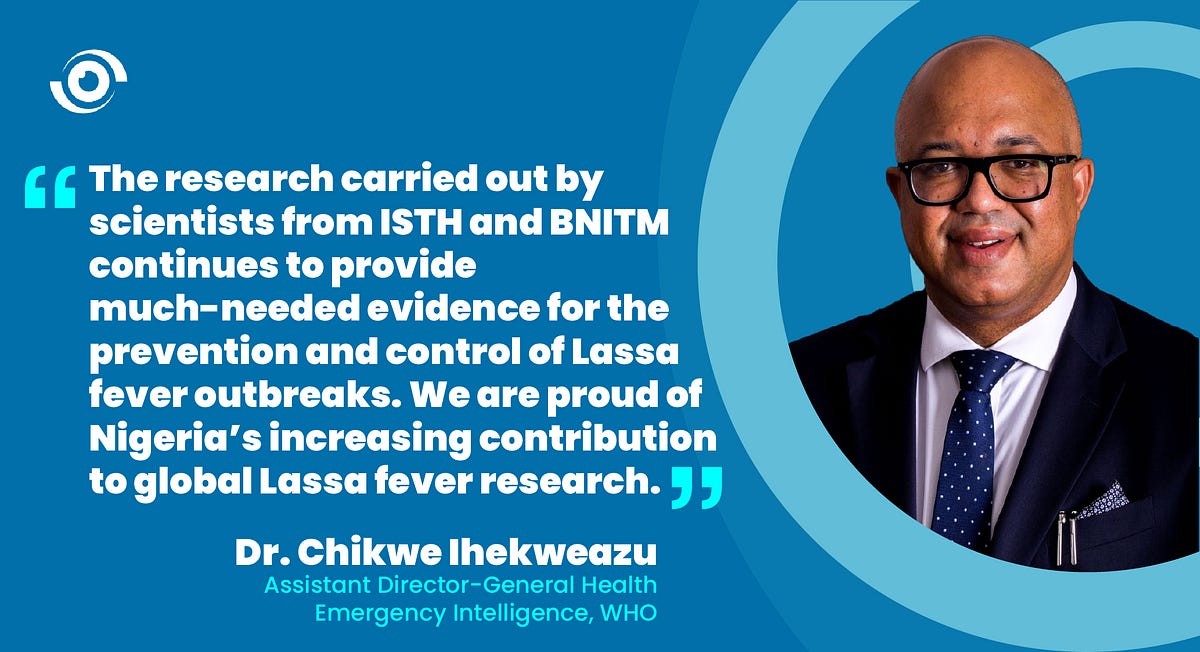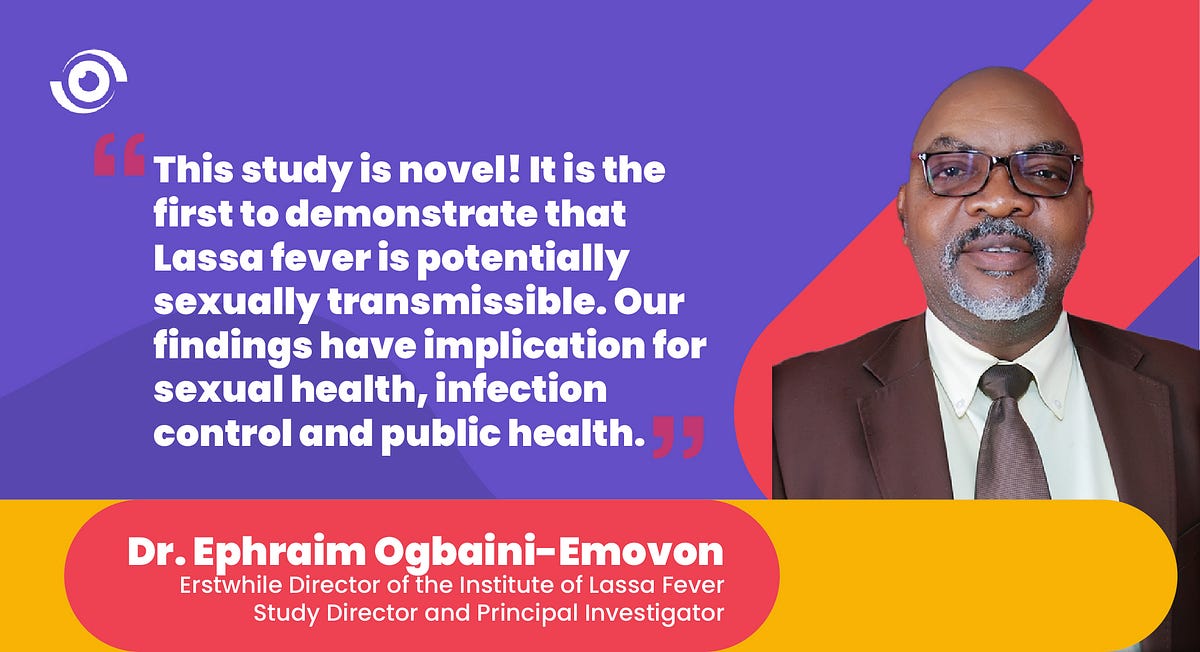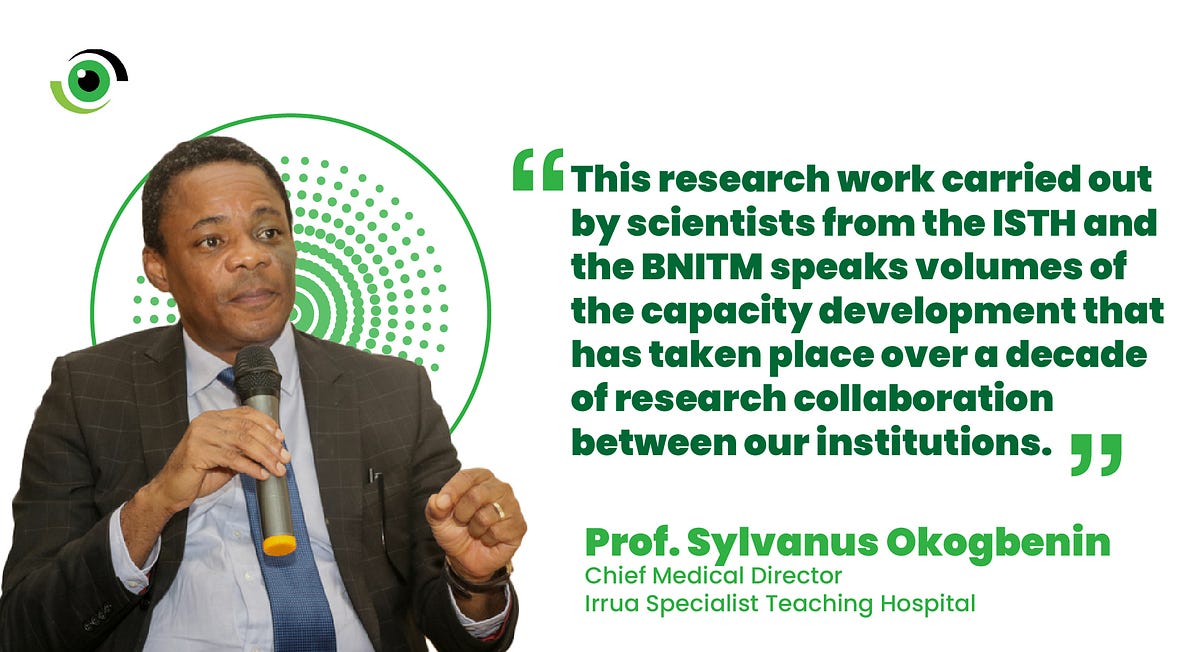Editor’s Note: In this commentary Professor Sylvanus. A. Okogbenin, the Chief Medical Director of Irrua Specialist Teaching Hospital, discusses the significance of a new ground breaking study just published by his team in the pre-eminent medical journal, The Lancet, in which they describe the persistence of the virus in patients after recovery from acute Lassa fever in Nigeria, and its impact on public health.
In November 2021, the results of a two-year study investigating Lassa virus persistence and clearance in various body fluids in a cohort of Lassa fever survivors were published. This ground breaking study titled “Virus persistence after recovery from acute Lassa fever in Nigeria: a 2-year interim analysis of a prospective longitudinal cohort study” showed that the Lassa virus persists in seminal fluid of patients up to 12 months after recovery from primary illness, implying a risk of sexual transmission of Lassa fever. This finding will inform the public health response to Lassa fever in Nigeria and beyond.
This study demonstrates the maturing capacity of scientists in Irrua Specialist Training Hospital (ISTH) to do excellent research, publishing in high impact medical journals and having real consequences for describing risk factors and control measures for diseases relevant to Nigeria.
This study was born out of the 15 years of research collaboration between ISTH and Bernhard Nocht Institute for Tropical Medicine (BNITM). It demonstrates the quality of the 15-year collaborative partnership between ISTH and BNITM. The conceptualisation, leadership, implementation and authorship is a demonstration of true scientific partnership and grit that enables the execution of a 2-year study of this quality. Credit goes to the dedication and commitment of scientists and clinicians from both institutions.
Dr Ephraim Ogbaini-Emovon, the erstwhile Coordinator/Director, Institute of Lassa Fever Research and Control, was the study director and principal investigator, while Dr. Anke Thielebein, a Virologist, led the team from the BNITM. Dr. Chikwe Ihekweazu, Assistant Director-General Health Emergency Intelligence, World Health Organisation (WHO), and who during his time leading the Nigeria Centre for Disease Control (NCDC) actively supported the Institute of Lassa Fever and Control commented on the findings — “The research carried out by scientists from ISTH and BNITM continues to provide much-needed evidence for the prevention and control of Lassa fever outbreaks. We are proud of Nigeria’s increasing contribution to global Lassa fever research and collaboration with institutions like BNITM that support our scientific and public health aspirations. In addition to the excellent science, we are developing the capacity of scientists that Nigeria needs to ensure continuous engagement with global R&D.”

Establishing presence and infectiousness in bodily fluids
Following emerging evidence of the transmission viral persistence and sexual transmission from recovered Ebola survivors, questions have been asked on whether this might be the case for Lassa fever as well. This study sought to determine the persistence and clearance of the Lassa virus from various body fluids and to establish infectiousness of persistent virus several months after treatment and discharge from the hospital.
Over a two-year period, over 4,800 samples from 159 patients were collected and analysed in the laboratory at Irrua Specialist Teaching Hospital. Results showed that one month after being discharged, Lassa viruses were still present in plasma, urine, saliva, lacrimal fluid, vaginal fluid and seminal fluid of Lassa fever survivors. However, all body fluids apart from the semen were free of the virus at three months. The semen continued to contain Lassa virus up to 12 months after discharge.
Specimens were then sent to a Biosafety Laboratory 4 in BNITM, Hamburg to test for infectiousness. This is a complicated test and is done in two stages — the persistent virus was used to infect cells and then cultured and further testing of infectiousness was done by inoculating immune compromised mice. The results showed that infectious viruses were found in seminal fluids up to 9 months after discharge from the hospital.
Dr. Anke Thielebein, Virologist and leader of the Bernhard Nocht Institute for Tropical Medicine research team commented on the study’s findings — “Our study results show that there is a significant risk for male survivors of Lassa fever to harbour infectious virus in their seminal fluid for a prolonged period after the acute disease. Especially men with a severe course should be informed that there is the risk to potentially sexually transmit the virus even six to nine months after their recovery. Patients need to be given the opportunity to get follow-up testing and adequate protective measures must be advised. Women should also have only protected sexual intercourse for a few months after their discharge from hospital”.

Impact of findings on sexual health
This finding is huge because of its potential implication for public health and the need to modify follow up recommendations. According to Dr. Ephraim Ogbaini-Emovon, erstwhile Coordinator/Director, Institute of Lassa Fever Research and Control, “This study is novel! It is the first to demonstrate that Lassa fever is potentially sexually transmissible. Our findings have implications for sexual health, infection control and public health. We now have the evidence to recommend barrier methods of preventing sexually transmitted diseases, such as the use of condom for male survivors of Lassa fever. In addition, sexual health education, counselling and post-discharge follow-up testing of male survivors is recommended to prevent further transmission of the disease. Furthermore, the results from this study form a good basis for further studies on the clinical implications for persisting virus in the male reproductive system.”
The authors rightly advised for a modification of follow-up practices. These should include counselling survivors on the potential risk of sexual transmission from male partners up to nine months after discharge, offering follow-up testing and counselling on the regular use of condom and safe sexual practices for at least one year. This should be particularly so for older men, who had severe Lassa fever disease or have partners who are immune compromised. Survivors also need to be counselled on the potential risk of transmission from other body fluids such as urine, plasma, lacrimal fluid and vagina fluid, up to one or two months after discharge.

This research work carried out by scientists from the ISTH and the BNITM speaks volumes of the capacity development that has taken place over a decade of research collaboration between our institutions. The relationship demonstrates the benefits of North-South research co-operation. The findings highlight the urgency for the development of a Lassa virus vaccine as an effective way for prevention. Lessons learned from the COVID-19 vaccine could help accelerate its development.
Lassa fever was first discovered in Nigeria in Lassa town of Borno State in 1969 after it claimed the lives of three missionary health care workers. Since then, there have been several outbreaks, with the disease becoming endemic in parts of Nigeria, with most cases reported in Edo, Ondo and Ebonyi States. In the West African sub-region where Lassa fever is most prevalent, it is estimated to cause 300,000 infections and 5,000 deaths annually. The high prevalence of the disease in Ekpoma/Irrua axis of Edo State led the Federal Government to designate the Irrua Specialist Teaching Hospital (ISTH), Edo State as a centre of excellence for the management and control of Lassa fever in 2002. However more concerted effort began in 2007/2008 with the establishment of the Institute of Lassa Fever Research and Control, now Institute for Viral Haemorrhagic Fever and Emergent Pathogens, located in Irrua Specialist Teaching Hospital.

An excellent partnership
The efforts of Scientists and Clinicians from the Irrua Specialist Teaching Hospital and collaborators from the BNITM have brought increased attention to the disease. Their effort, combined with the increasing frequency and magnitude of annual outbreaks led the WHO to prioritise Lassa fever as a disease for research and development (R&D) of new therapeutics and vaccine. Fortunately, the ISTH provides a conducive environment for direct investment in Lassa fever research.
Professor Sylvanus .A. Okogbenin is the Chief Medical Director of Irrua Specialist Teaching Hospital as well as Professor of Obstetrics and Gynaecology at Ambrose Alli University, Ekpoma, Edo State.



Great and important study of public health significance
Dear Professor Tomori,
Thank you for your comment. We hope the findings will inform post recovery counselling for patients that have recovered from a Lassa fever infection.
This is an excellent work born out of dedication and total commitment to excellence in research, management and control of Lassa Fever in ISTH. Our team of experts led by Prof. Sylvanus A. Okogbenin are simply Indefatigable. I am forever proud to be associated to this SUCCESS as a member of the Case Management team.
wonderful research!
This study is indeed ingenious. Prof S. A. Okogbenin and his infectious disease team at ISTH, Irrua in collaboration with BNITM, one of the most prestigious tropical medicine research institute in Europe, really went in depth in innovative research to come to this previously unknown discovery in the pathogenesis and infective nature of Lassa Fever virus. It is a revolutionary finding with a huge impact on public health issues concerning Lassa fever.
This is a great work indeed and it underscores the need for patient counselling and education to be incorporated in the management of Lassa Fever. Well done ISTH.
Very informative as regards management of Lassa fever for possible disease control.
the result shows that LASV is sexually transmitted.
Nice to know that this is happening in an institution where I had my undergraduate medical training. This has again drawn attention to the fact that Lassa is still with us despite being seemingly masked by the COVID-19 pandemic. I had sometime ago interacted with Prof. Danny Asogun of your institution on the need to look at the impact of COVID-19 on Lassa fever, a research focus that I was interested in but I had to proceed to University of Witwatersrand in Johannesburg for other research interests. I recommend that your institution look in this direction if not already as there is still so much novelty in Lassa research.
Overall, am proud of your team, Prof Sylvanus Okogbeni was my teacher and Dr Ogbaini-Emovon a longstanding friend, am not therefore surprised that they are making this much of the limited resources in that environment.
Thank you for the good work.